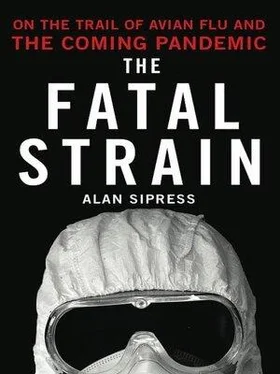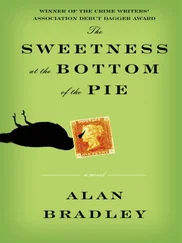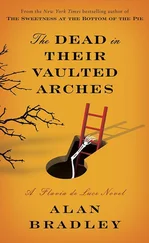Hong Kong residents with little more than sniffles streamed to hospitals and clinics, fearing the worst. In normal times, these health centers took only a few samples each day from suspected flu cases. But now the samples were being wheeled into Wilina Lim’s lab by the trolleyful, at least five hundred specimens every day. And health officials were demanding that the lab analyze them immediately for H5N1, rather than screening them first to see if they were flu at all. The workload overwhelmed the small influenza lab and its staff of two technicians. Lim yanked staff from the hepatitis and HIV labs and put them to work on flu, more than twelve hours a day, seven days a week.
Most samples came back negative. But the few that were positive made a terrifying impression. To Lim, this virus behaved like an alien. Her lab, adhering to international norms, normally tested for flu by culturing the virus in special cells harvested from the kidney tissue of cocker spaniels. Scientists consider these canine cells to be especially good for growing flu viruses, far better than most other types of cells. So it was little surprise when Lim’s technicians placed the virus into the canine cells and it grew. But when they inserted it into a variety of other cells to see what would happen, they were stunned by what they saw under the microscope. “This one, it grows well in all kinds of cells,” Lim recalled. “You can see the cell change very quickly. It seems that whatever cell you put it in, it just grows.”
The long hours were also taking their toll on Margaret Chan, who was often up until the middle of the night speaking with anxious WHO officials in Geneva. But as the face of the health department, she tried to remain cool and upbeat. Once she went too far. Accosted by reporters after delivering a luncheon speech, she was asked whether she still ate chicken despite the flu scare. “Yes, I eat chicken every day. Don’t worry,” Chan told them reassuringly. Her response was scientifically sound, since the virus cannot spread in cooked meat. But to many in panicky Hong Kong, her answer seemed frivolous and out of touch. It sparked a brief furor in the local media, and she later admitted she’d fumbled the public relations.
In the privacy of her office, by contrast, Chan and her senior lieutenants were growing extremely worried. “Has the situation got out of hand?” Tsang recalled them wondering at one meeting. The disease seemed to be spreading exponentially. They suspected it might now be jumping from one person to another. They feared that hundreds of thousands in the city could soon fall sick. They still didn’t understand where the virus was coming from, so they didn’t know how to stop it.
Hong Kong’s senior health officials looked to Fukuda for reassurance. But now he, too, was frightened, and his anxiety showed. Unlike in August, he was in the middle of a storm with no end in sight. Moreover, time was running out. In just a few more weeks, Hong Kong would enter its regular winter flu season, and Fukuda feared that the convergence of prosaic and novel infections would overwhelm the city’s hospitals since there was no easy way to tell them apart. Even worse, if both strains were circulating at the same time, the opportunity for them to swap genes and spawn an epidemic strain would be tremendous. “All of that was very pressing,” he said. “We were racing against time.”
* * *
“It was striking that this was not regular influenza we were looking at, whatever it was,” Fukuda later told me. Ordinary flu preyed on the weak: infants, the elderly, and the infirm. But this strain had demonstrated that even the young and healthy—especially the young and healthy—were its targets. “What does it look like?” he asked. “It looks like young people dying from something new. So it really brought us back to 1918.”
The parallels were eerie. Ordinary flu has what scholars describe as a U-shaped mortality curve, with deaths concentrated among the very young and very old and a far lower proportion among those in between. The milder pandemics of 1957 and 1968 adhered to the same pattern. But during the Spanish flu of 1918, more than half the deaths were among those between eighteen and forty. This gave the disease a W-shaped mortality curve, reflecting the heavy toll in the middle of life as well as at the beginning and end. The avian flu outbreak in Hong Kong was much the same. And after the virus resurfaced in 2003, spreading its reach across much of East Asia, the deaths continued to follow this disquieting pattern. The largest toll was among those between ages ten and nineteen, followed by those in their twenties. The overall case-fatality rate was highest among those between ages ten and thirty-nine.
“Most of the time in public health and in medicine,” Fukuda continued, “there’s a fair amount of uncertainty, but you rarely come across issues where there’s a really high degree of uncertainty and what you’re sitting on may be something like a 1918. You feel like, ‘I don’t know what is going to happen. I don’t know what is going on. But what is going on is not good, and what it reminds me of is the worst not-good of the century.’”
Researchers have yet to account fully for why the Spanish flu and avian flu, alone among contemporary flu outbreaks, manifest this W-shaped curve. “Explaining the extraordinary excess mortality in persons 20-40 years of age in 1918 is perhaps the most important unsolved mystery of the pandemic,” wrote researchers at the U.S. National Institutes of Health. The answer could lie with another uncanny similarity between the two viruses. Historical accounts from 1918 and experiments on a version of the Spanish flu strain resurrected in the lab reveal that it also provoked tremendous cytokine storms, those withering counterattacks by the body’s immune system. Scientists speculate that the young and healthy may be most vulnerable because, ironically, they have the most robust immune systems, thus the ones that launch the most vicious and ultimately suicidal responses. These victims may be undone by their own strength.
Scientists’ understanding of this novel bird flu strain is still evolving, and the more they learn, the more they worry. Some now suspect that bird flu is moving down the same path as the virus responsible for the deadliest epidemic in human history. “This is a kissing cousin of the 1918 virus,” warns Michael Osterholm, director of the Center for Infectious Disease Research and Policy and a frequent commentator on the pandemic threat.
Spanish flu, like bird flu, is thought by scientists to have been a wholly avian virus that developed solely through a series of internal mutations, as opposed to the genetic reassortment that spawned the 1957 and 1968 strains in addition to the swine flu of 2009. Some of the mutations discovered in the 1918 virus look familiar. “Notably, a number of the same changes have been found in recently circulating, highly pathogenic H5N1 viruses that have caused illness and death in humans and are feared to be the precursors of a new influenza pandemic,” wrote a team of researchers led by Jeffrey Taubenberger, the American scientist who first fully analyzed the genes of the 1918 virus. Just since 1997, bird flu has become more like the Spanish flu strain. A series of studies shows bird flu has grown more virulent and less susceptible to antiviral drugs. “The H5N1 avian flu viruses are in a process of rapid evolution,” said researcher Elena A. Govorkova in 2005. “We were surprised at the tenacity of this new variant.” A later lab study suggested that bird flu may have already become more ferocious than the 1918 virus, laying even greater waste to the respiratory system and, fiendishly, targeting those lung cells specifically involved with repairing damaged tissue. In September 2006, WHO brought the world’s premier flu specialists to Geneva to scrub the evidence. Malik Peiris, the renowned microbiologist from Hong Kong, told the three dozen participants at this private session something that took their breath away. If the virus continued to develop along the same path, ultimately emerging as a pandemic strain through internal mutation rather than genetic reassortment, its high lethality could persist. He concluded there was no scientific reason for expecting a decrease in the fatality rate, currently at 60 percent of recorded cases. His comments, though later reported by WHO, were largely overlooked by the media. Their import was horrifying. Once the virus evolved into a form easily passed among people, it would be expected to infect a quarter of humanity. So even if the actual fatality rate was only 50 percent after accounting for overlooked mild cases, this could mean the deaths of nearly a billion people.
Читать дальше











